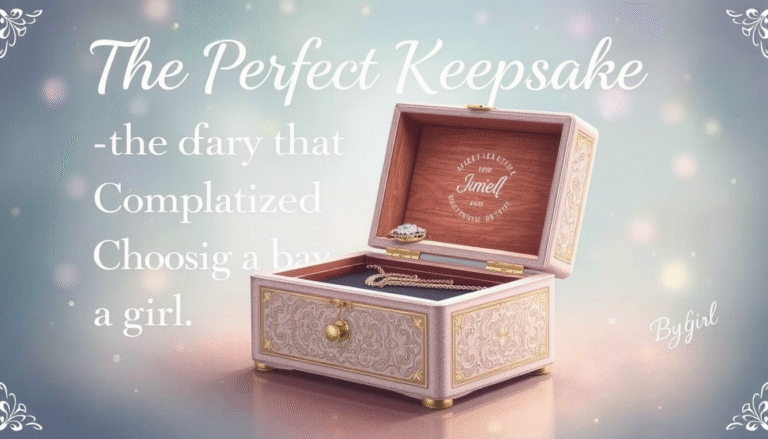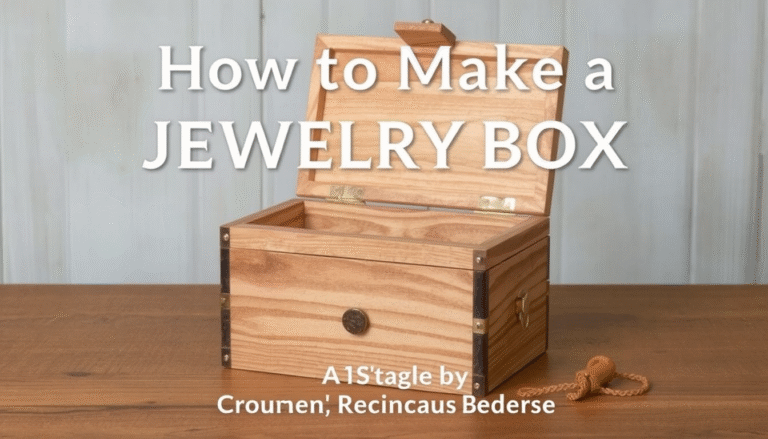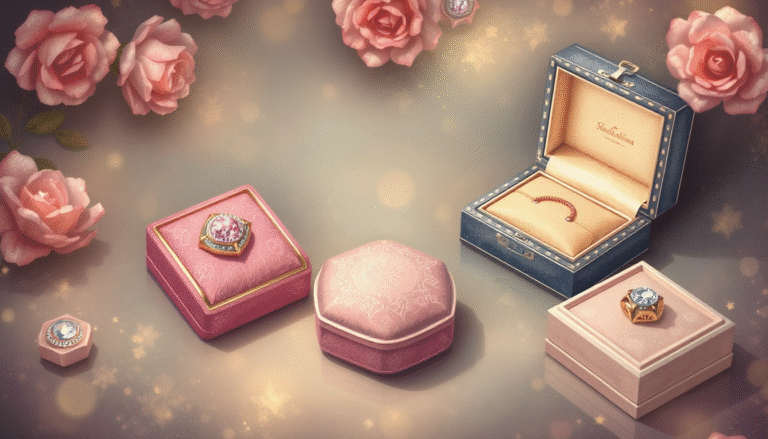The design process begins long before you cut the first piece of wood. This is where you turn a simple idea into something both useful and beautiful. We will walk you through how to design a jewelry box, from your first idea to the final touches.
We’ve organized this guide to follow how professionals design. You’ll have a complete plan for your project when you finish reading.
-
Phase 1: Defining Your Vision (The “Why” and “For Whom”)
-
Phase 2: Choosing Your Aesthetic (The “Look and Feel”)
-
Phase 3: Selecting Your Materials (The “Substance”)
-
Phase 4: Planning for Functionality (The “Inside Story”)
-
Phase 5: Bringing it to Life (The “How-To”)
Phase 1: The Design-First Framework: Answering the 5 Core Questions
.png)
Before we even get into wood or joinery, we need to begin with a blueprint. It’s a frame that ensures every decision is justified. By answering these five questions, you’ll be able to avoid a few common mistakes, including making a box that’s the wrong size, or one that doesn’t relate to the context in which it will sit.
1. Who is the recipient?
First, think about the person. Are you sewing this for yourself to reflect your style? Perhaps it’s a present for a partner who appreciates contemporary lines, or a grandmother who relishes something decorated and old-fashioned. The person’s taste should inform your entire design.
2. What will it hold?
Your design has to do the job for it’s purposes. What will the box be used to store, big necklaces, small rings and earrings, expensive watches, or a combination of everything? The contents will determine the internal design and size of the box.
(For instance, ring slots should be approximately 1 to 1.5 inches wide, which will allow rings to fit snugly.) Sections of a necklace may require 6 inches or more of space to avoid tangling, a common issue. Be precise about the role now to avert issues later.
3. Where will it live?
Your jewellery collection is also part of your home decor. Picture where it will sit. Will it live on a dark wood dresser, a simple white vanity or a packed bookshelf? Where it will go affects your selection of materials and colors, so the resulting box relates to its location rather than sticking out like a sore thumb.
4. What is your skill level and what tools do you have?
Be honest about what you can do and what tools you own. Are you new to woodworking with just basic hand tools, or are you skilled with a full workshop? Your abilities will determine how complex your box design can be. A simple, well-made box is much better than an ambitious project with flaws.
5. What is the story you want it to tell?
Here is the core of your design. Is it a box made of old barn wood sharing a tale of the past? Is it a modern sideboard with straight lines and stunning wood grain? Or is it a fancy, carved heirloom that would be passed down through the generations? This emotional intent will inform your finishing decisions.
To make your vision clear, use this summary as your project’s plan.
| Design Brief Checklist | Your Answer |
| Recipient & Style: | (e.g., “For my sister, who loves minimalist design.”) |
| Primary Contents: | (e.g., “Rings, stud earrings, and 2-3 fine chain necklaces.”) |
| Final Location: | (e.g., “On a light-colored oak nightstand.”) |
| My Skill Level: | (e.g., “Beginner comfortable with simple cuts.”) |
| The Story/Feeling: | (e.g., “A clean, elegant, and personal gift.”) |
Phase 2: Choosing Your Aesthetic: From Modern Minimalist to Rustic Charm

With your design brief done, you should know exactly what you’re aiming for. We can make those concepts into a real style. Knowing these common styles will provide you with words to seek out more inspiration and shape your vision.
-
Modern/Minimalist
-
Characteristics: Clean lines, plain surfaces, and hidden joints. The natural wood pattern is the main feature. Often has built-in lid lifts instead of visible hardware.
-
Best Materials: Maple, Ash, Walnut, Bamboo.
-
Traditional/Heirloom
-
Characteristics: Fancy details like carved feet, decorative edges, and rich finishes. Insides are almost always lined with felt or velvet, with decorative hardware.
-
Best Materials: Mahogany, Cherry, Oak.
-
Rustic/Farmhouse
-
Characteristics: Celebrates imperfection and strong construction. Look for visible joints (like dovetails), reclaimed wood textures, worn-looking finishes, and simple, strong hardware.
-
Best Materials: Pine, Reclaimed woods, Cedar.
-
Art Deco/Vintage
-
Characteristics: Bold geometric patterns, often created with contrasting wood inlays (like Ebony and Holly). Features shiny, lacquered finishes and stylized, old-fashioned hardware.
-
Best Materials: Combinations of local and exotic veneers.
Finding a plan that you can adapt to your chosen style is a great next step. You can start by drawing inspiration from a variety of styles and then changing the details to match your unique design brief.
Phase 3: The Soul of the Box: Selecting and Combining Materials

The materials you pick are what build your design. They add heft, texture and character to it. A rare and exceptional custom jewelry box is made when well selected heart wood, hardware, and lining are brought together. This symmetry is the difference between a good project and a great one.
Choosing the Primary Wood
The wood makes up the body of the box. Your decision will ultimately result in differing aesthetics and building method. We recommend hardwoods for strength and good looks.
Here’s a look at some of the top-rated options for a premium jewelry box:
| Wood Type | Appearance | Workability (Ease of Use) | Average Cost |
| Walnut | Rich, dark brown with beautiful grain. Creates excellent contrast. | Works well with both hand and power tools. | $$$ |
| Cherry | Pinkish-red that darkens to a deep reddish-brown with age. Classic & elegant. | Machines and sands to a very smooth finish. | $$$ |
| Oak | Strong, prominent grain pattern. Very durable and traditional. | Can be prone to splintering; sharp tools are a must. | $$ |
| Poplar | Light cream color with green/gray streaks. Inexpensive and versatile. | Very easy to work, but soft and dents easily. Best for painted boxes. | $ |
The Finishing Touches: Hardware and Lining
These details complete the look and improve the user experience.
Hardware is the “jewelry for the jewelry box.” The style should directly reflect your chosen aesthetic.
-
Brass hardware is timeless, working equally well for elegant Traditional and refined Modern boxes.
-
Brushed Nickel or chrome offers a sleek, cool feel, making it ideal for Minimalist designs.
-
Wrought Iron or antiqued brass hardware has a hand-forged look that perfectly complements Rustic and Farmhouse styles.
Lining protects valuables and adds a touch of luxury. It’s the soft layer between the box and its precious contents.
-
The usual,traditional choice would be felt. It’s inexpensive, easy to locate and fairly straightforward to teach with.
-
Velvet or velveteen is a little more plush and luxurious, which makes it perfect for fancy boxes meant to store special heirlooms.
-
Leather or suede is a premium, resilient material. It’s a great choice if you’re want something that will look a little more masculine or a little more contemporary.
In both types of felt application we have experienced, a good quality spray adhesive results in much smoother overall, wrinkle-free finish than white glue does. Before applying on your project try out the technique on a scrap piece of wood to get a feel for how tacky the spray is and how quickly it dries.
Phase 4: Function Meets Form: Designing the Perfect Interior

Now, we have interior design. A gorgeous box that doesn’t keep jewelry organized doesn’t win cookie points. What will it hold?” into an answer. into a practical, functional layout.
-
Start with an Inventory
Spread all of the jewelry the box can hold out. Sort items by category: rings, watches, bracelets, necklaces, stud earrings, and the like. This physical inventory will allow you to see how much space all the categories require. -
Design Ring Storage
For a ring collection, dedicated storage is a must. You can create padded ring rolls or simple divided slots. For a very professional look, consider buying pre-made foam ring inserts that you can cut to size and wrap in your lining material. Many woodworkers also focus on creating custom dividers and trays from thin hardwood for a fully integrated design. -
Create Open Compartments
For bracelets, brooches and large earrings, larger, open compartments are ideal. To add flexibility to the design, utilize removable dividers cut from 1/8-in.-thick plywood or hobby board. This means that the user can make changes in the space as their collection grows. -
Plan for Necklaces
Tangled necklaces are just the worst. Inteercept the specific issue in your design. Solutions include attaching little, decorative hooks to the inside of the lid or purpose-making long, skinny chambers where chains can lay flat. -
Consider Adding Trays
A shallow, lift-out tray is a lovely layer of utility. It’s a space for frequently worn items to live, where they can be given a little distance, but not be too hard to reach. It does make construction a little more complicated, but a well-fit tray can make any jewelry box much more functional.
Phase 5: From Paper to Project: Bringing Your Design to Life
Your design is complete. You have a floor plan specifying the orientation, type, color and material for your custom jewelry box. Now you just have to decide how to make it.
The DIY Woodworker’s Path
If you have a shop, obviously your design is your tutorial. You are free to browse for some project plans corresponding to the style and difficulty of projects you have set. And remember, the plans are not carved in stone; they are starting points that you can adjust to your custom dimensions and details. For more experienced woodworkers, take your design and make a detailed “cut list” — the master list of every piece and its exact dimensions.
The Customization Path (No Workshop Required)
But you can absolutely make a stunning, customized box without any power tools. Begin with a basic, unfinished pine or basswood box from a craft shop. This becomes your blank canvas. Use your design brief to influence your finishing decisions — giving it a paint color, using stencils or decoupage, or creating a vinyl monogram using a Cricut machine- the list goes on. This method emphasizes the surface decoration to get the look you want.
The Commissioning Path
If you do not have the time or need guidance, your design brief can serve as a great way to hire a professional. You can shop for local woodworkers or custom artisans in marketplaces like Etsy. Your providing them with the finished design framework—recipient, function, style and materials—makes it easy for them to read your mind. That clarity is crucial to the success of our collaboration and to a finished work that serves your needs.
Conclusion: Your Design is a Story in a Box
A beautifully crafted jewelry box truly marries personality, style, and function. It’s not something that holds just treasures, but something that will hold meaning.
By sticking to this design-first process — defining the purpose, choosing an aesthetic, selecting materials, planning out the inside — you’ve made something much greater than a paint-by-numbers home. You have a full plan here for a truly YOURS piece of work.
Now you need to get your design built. Have fun while making it, a gorgeous home for your treasures!
FAQ
-
How do I determine the right size when I design a jewelry box?
Lay all the pieces the box will contain together and separate by type, taking measurements to plan your overall design to accommodate everything with its own compartment. -
What are the best materials to design a jewelry box in 2025?
In 2025, hardwoods, including walnut, cherry and oak are still popular, and sustainable bamboo and reclaimed woods are becoming hot choices for the environmentally conscious jewelry box. -
How can I design a jewelry box with modern technology integration?
Some of the newest jewelry boxes in 2025 can have LED inside lights, biometric locks and even climate control to keep the family jewels safe – without looking like a safe. -
What’s the most important consideration when I design a jewelry box?
Receiving party’s MIL style and jewelry collection The recipient’s preferred MIL style and the jewelry her new MIL’s in with … ||= jewelery receiving MIL will go in: These two things should determine your entire design so the piece will be functional and have personal meaning. -
Can beginners successfully design a jewelry box without advanced woodworking skills?
Absolutely! For beginners, starting with customizing premade boxes or using straightforward construction and concentrating on innovative design features and finishing details may be best.





